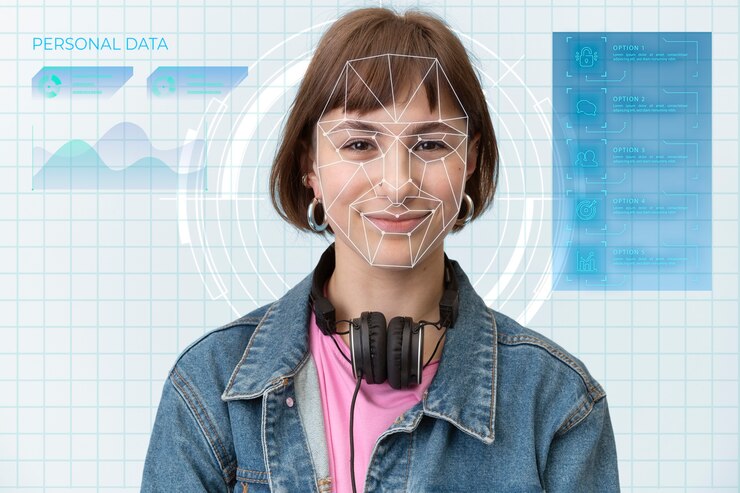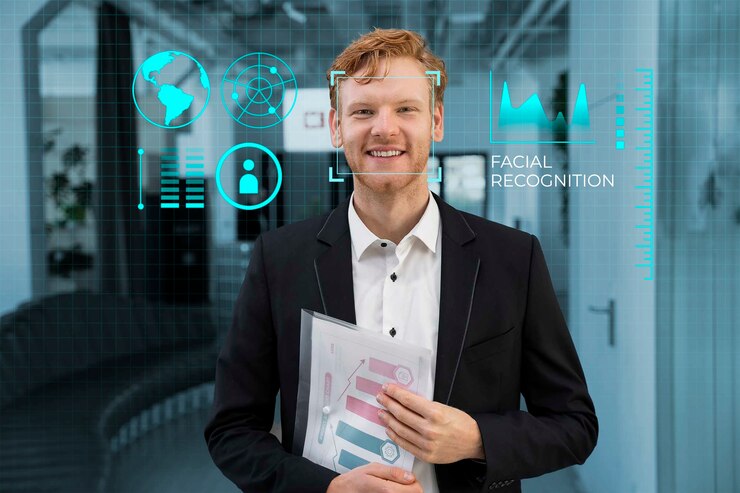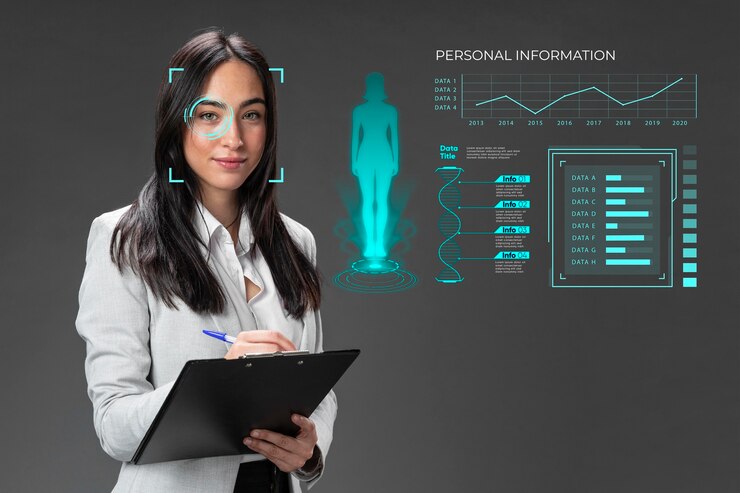Biometrics is used by various industries, including government, law enforcement, healthcare, and financial institutions. It is also used in consumer electronics such as smartphones and laptops to provide secure access.
Biometrics, the use of unique biological characteristics for identification, has become increasingly prevalent across a wide range of sectors. In government and law enforcement, biometrics are utilized for border control, criminal identification, and national security. In the healthcare industry, biometric technologies are employed to ensure patient safety and accurate record-keeping.

Financial institutions use biometrics for secure authentication and fraud prevention. Additionally, consumer electronics companies integrate biometric features into their devices for convenient and secure access control. With the ability to provide reliable and efficient means of identification, biometrics has become a crucial tool for enhancing security and efficiency across various sectors.
The Basics Of Biometrics
Biometrics refers to the measurement and statistical analysis of people’s unique physical and behavioral characteristics. The technology is mainly used for identification and access control purposes. The utilization of biometrics has continued to evolve and expand as technology advancements improve accuracy and usability.
Definition Of Biometrics
Biometrics is a method of recognizing individuals based on their unique physical or behavioral traits. These characteristics can include fingerprints, facial features, iris patterns, voice, and even gait.
Evolution Of Biometric Technology
Biometric technology has come a long way since its inception, with continuous improvements in accuracy, speed, and reliability. Earlier systems primarily focused on fingerprint recognition, but advancements have led to the integration of various modalities, such as facial and iris recognition, to enhance security and usability.
Applications Of Biometric Systems
Biometric systems have found applications across a wide range of industries and sectors. These include access control for sensitive facilities, identity authentication for digital transactions, time and attendance tracking in workplaces, and even border control and law enforcement purposes.

Who Uses Biometrics?
Biometrics technology is rapidly gaining popularity as a secure means of identity verification. This advanced technology analyzes and measures unique physical and behavioral characteristics, offering a reliable way to authenticate individuals. From government agencies to financial institutions and healthcare providers, a diverse range of industries are embracing biometrics to enhance security and streamline processes.
Goverment And Law Enforcement Agencies
Government and law enforcement agencies are among the primary adopters of biometric technology. They utilize it for various purposes, such as border control, national security, criminal identification, and access control to sensitive areas. By employing biometrics like fingerprints, facial recognition, and iris scanning, authorities can accurately identify individuals and prevent unauthorized access to critical facilities.
Financial institutions and the banking sector rely on biometrics to fortify their security measures. Biometric authentication methods, such as fingerprint and voice recognition, are employed to verify customer identities during account access, ATM transactions, and online banking activities. This technology helps prevent fraudulent activities and enhances the overall security of financial transactions.
The healthcare industry is increasingly integrating biometrics to ensure accurate patient identification, secure access to medical records, and prevent medical identity theft. Hospitals and healthcare facilities use biometric solutions to authenticate patients and provide secure access to sensitive medical data, thus safeguarding patient privacy and improving the efficiency of medical services.
Educational institutions are also embracing biometrics to enhance campus security, manage student attendance, and streamline administrative processes. Biometric systems, such as fingerprint or facial recognition, aid in accurately tracking student attendance, controlling access to restricted areas, and ensuring a safe learning environment.
Government And Law Enforcement Agencies
Government and law enforcement agencies utilize biometrics as a powerful tool to enhance security and ensure the accuracy of identification processes. By leveraging biometric technology, these entities are better equipped to prevent and solve crimes, manage border control, and safeguard national security.
Integration Of Biometrics In Identification And Security Systems
Biometric systems are integrated into various identification and security processes within government and law enforcement agencies. From access control to secure facilities to verifying the identity of individuals during criminal investigations, biometrics play a crucial role in maintaining the integrity of these systems.
Crime Prevention And Investigation
Biometrics is extensively used in the prevention and investigation of crimes. Law enforcement agencies utilize biometric data such as fingerprints, facial recognition, and iris scans to identify suspects, match evidence to individuals, and ultimately solve criminal cases. This technology has significantly enhanced the efficiency and accuracy of criminal investigations.
National Security And Border Control
Biometric technology is an essential component of national security and border control efforts. Government agencies use biometric systems to authenticate the identity of travelers, monitor border crossings, and enhance security protocols. By deploying biometric solutions, authorities can effectively manage border security and stay vigilant against potential threats to national security.
Financial Institutions And Banking Sector
The financial institutions and banking sector are increasingly implementing biometric technology to enhance security, streamline processes, and improve customer experience. Biometric authentication is revolutionizing the way financial institutions operate by providing a secure and convenient method for verifying the identity of their customers.
Biometric Authentication In Online Banking
Financial institutions are integrating biometric authentication methods such as fingerprint, iris, and facial recognition into their online banking platforms. This provides customers with a seamless and secure way to access their accounts and perform transactions without the need to remember complex passwords.
Cashless Transactions And Atm Security
Biometrics plays a crucial role in ensuring the security of cashless transactions and ATM operations. By using biometric authentication at ATMs, financial institutions can prevent unauthorized access and protect customers from card skimming and other fraudulent activities.
Fraud Prevention And Customer Identity Verification
Biometric technology is helping financial institutions in preventing fraud and ensuring customer identity verification. With the use of biometric data, institutions can accurately authenticate customers, reducing the likelihood of identity theft and unauthorized access to accounts.
Healthcare Industry
The healthcare industry is one of the key sectors leveraging biometrics technology to improve efficiency, enhance security, and ensure accurate patient identification. From managing medical records to controlling access to restricted areas, biometrics plays a crucial role in enhancing operational workflows and safeguarding sensitive information.
Patient Identification And Medical Records Management
Patient identification is a critical aspect of healthcare delivery. Biometric technologies such as fingerprint, palm vein, or iris recognition systems are being utilized to accurately identify patients and link them to their medical records. Through the use of biometrics, healthcare providers can mitigate the risks associated with patient misidentification, ensuring that each individual receives the right care and treatment.
Prescription Drug Dispensing And Control
In the healthcare environment, prescription drug dispensing and control are crucial processes that require strict monitoring and validation. Biometric authentication can be implemented to verify the identity of healthcare professionals and patients when dispensing medications, thereby reducing the likelihood of medication errors and ensuring accountability in drug administration.
Biometric Access To Restricted Areas In Hospitals
To bolster security and regulate access within healthcare facilities, biometric systems are employed to manage entry into restricted areas such as surgical suites, pharmaceutical storage areas, and medical laboratories. Biometric access control measures help healthcare organizations maintain a secure environment while ensuring that only authorized personnel can gain entry to sensitive zones, thereby safeguarding patient information and valuable medical resources.
Educational Institutions
Add meta tags, title, and other necessary elements here
Educational institutions are increasingly turning to biometric technology to enhance security, streamline administrative processes, and provide a seamless experience for students, faculty, and staff. Biometrics offer a range of applications within educational settings, benefiting from their accuracy, efficiency, and convenience.
Student Attendance Tracking And Academic Record Management
Biometric systems are revolutionizing student attendance tracking and academic record management within educational institutions. By implementing biometric solutions such as fingerprint or facial recognition technology, schools and universities can accurately record student attendance, eliminating the potential for proxy attendance and ensuring precise tracking of student participation. Biometrics also facilitate the efficient management of academic records, enabling secure and reliable authentication of student identities for tasks such as exam administration, grade submissions, and academic transcript issuance.
Access Control To Secure Sensitive Data And Resources
Access control is a critical aspect of safeguarding sensitive data and resources within educational institutions. Biometric authentication offers an advanced security solution that mitigates the risks associated with traditional access credentials like keys, ID cards, and passwords. Through biometric access control systems, educational facilities can restrict unauthorized entry to confidential areas, including laboratories, administrative offices, and document repositories, thereby enhancing overall security and privacy protection.
Implementation Of Biometric Systems For Campus Security
For educational institutions, maintaining a secure campus environment is paramount. The implementation of biometric systems serves as a key strategy in fortifying campus security. By employing biometric authentication for physical access, such as entry gates and building entrances, schools and universities can safeguard their premises against unauthorized intrusions, thereby mitigating potential threats and enhancing the safety of students, faculty, and staff.
Frequently Asked Questions On Who Uses Biometrics?
What Profession Uses Biometrics?
Biometrics is used in various professions like law enforcement, healthcare, banking, and government agencies.
What Are Biometrics Most Commonly Used For?
Biometrics are commonly used for identity verification in access control, time and attendance tracking, and mobile device security. They provide secure and convenient authentication through unique biological traits like fingerprints, iris scans, and facial recognition.
Who Uses Biometric Authentication?
Biometric authentication is used by individuals and organizations for secure access and identification. It provides a reliable and convenient way to verify identity.
What Organisations Use Biometrics?
Biometrics is used by government agencies, financial institutions, healthcare organizations, and businesses for security and identity verification purposes.
Conclusion
Biometrics are utilized by various industries, from finance to healthcare, and by individuals for personal devices and security. The widespread adoption of biometric technology showcases its importance in enhancing security and user experience. As technology continues to advance, the applications of biometrics will only expand further across different sectors and scenarios.
